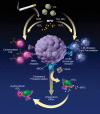Myeloperoxidase, modified lipoproteins, and atherogenesis
- PMID: 19091698
- PMCID: PMC2674690
- DOI: 10.1194/jlr.R800086-JLR200
Myeloperoxidase, modified lipoproteins, and atherogenesis
Erratum in
- J Lipid Res. 2009 Jun;50(6):1255
Abstract
Numerous lines of evidence implicate a role for myeloperoxidase (MPO) in the pathogenesis of atherosclerosis. Enriched within vulnerable plaque, MPO serves as an enzymatic source of eicosanoids and bioactive lipids and generates atherogenic forms of both low- and high-density lipoproteins. These factors likely contribute to clinical studies demonstrating that increased systemic levels of MPO and its oxidation products predict increased cardiovascular risk. As a result, interest has focused on the potential to target MPO for the development of new risk markers, imaging, and therapies to prevent cardiovascular events.
Figures

References
-
- Klebanoff S. J. 1980. Oxygen metabolism and the toxic properties of phagocytes. Ann. Intern. Med. 93 480–489. - PubMed
-
- Kutter D., P. Devaquet, G. Vanderstocken, J. M. Paulus, V. Marchal, and A. Gothot. 2000. Consequences of total and subtotal myeloperoxidase deficiency: risk or benefit? Acta Haematol. 104 10–15. - PubMed
-
- Zhang R., M. L. Brennan, Z. Shen, J. C. MacPherson, D. Schmitt, C. E. Molenda, and S. L. Hazen. 2002. Myeloperoxidase functions as a major enzymatic catalyst for initiation of lipid peroxidation at sites of inflammation. J. Biol. Chem. 277 46116–46122. - PubMed
-
- Podrez E. A., H. M. Abu-Soud, and S. L. Hazen. 2000. Myeloperoxidase-generated oxidants and atherosclerosis. Free Radic. Biol. Med. 28 1717–1725. - PubMed
Publication types
MeSH terms
Substances
LinkOut - more resources
Full Text Sources
Other Literature Sources
Medical
Research Materials
Miscellaneous

